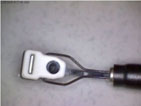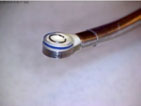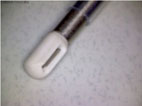| Device | Glider | Paragon-T2 | Ceruleau |
|---|---|---|---|
| Device Tip Design |  |
 |
 |
| Active Electrode Configuration | Flat electrode; Direct Tissue Contact | Ring Electrode; Direct Tissue Contact | Protected Electrode; Mechanical Housing |
| RF Generator System | Vulcan-EAS Smith and Nephew | Atlas Arthrocare | Force FX-C Valley Lab |
| Electrosurgical Design | Monopolar | Bipolar | Bipolar operating from monopolar output |
| Electrosurgical Mode | CUT | CUT | COAG4 |
| Power Output Settings | 60 Watts | 155-170 Watts | 25 Watts |
| Power Control | Manufacturer Preset Level 27 | Manufacturer Preset Level 6 | Surgeon Controlled |
| Approximate Electrode Surface Area Contacting Tissue 1 | 0.9 mm2 | 2.3 mm2 | Non-Contact |
| Power Density at Tissue Surface 2, 3, | 69 W/mm2 | 67-73 W/mm2 | 2.3 W/mm2 |
1 Approximate surface area measurements of the Glider and Paragon active electrodes available for radiofrequency emittance. Both active electrodes are in direct contact with tissue and deposit energy deep into the tissue's substance. The Ceruleau electrode resides and performs its work within a protective electrically insulating housing that inhibits electrode-totissue contact; therefore, the electrode surface area is not a significant factor at the tissue surface.
2 Power Density equals the power deployed through the exposed electrode surface area and reveals the power density required for direct-contact cartilage tissue ablation. The Glider and Paragon results are remarkably similar indicating a common threshold for inducing cartilage ablation, despite the differences in delivery modality between monopolar and bipolar, which demonstrates that the physical product design can offset energy delivery method.
3 A power density analysis of Ceruleau requires an area measurement of the openings in the protective housing and the distance of the electrode from the tissue surface. The power density at the tissue surface is approximately a 30 fold decrease from that of Glider and Paragon. Ceruleau operates at a higher nominal Voltage in COAG mode; therefore, the current density (the component of power density most responsible for ablation) at the tissue interface is further reduced from that of the ablation-based modalities.
4 Ceruleau is designed for use in a bipolar mode from a monopolar COAG output. These COAG waveforms are biased towards high peak-to-peak voltage levels in comparison to ablation-based systems with a higher current level bias.